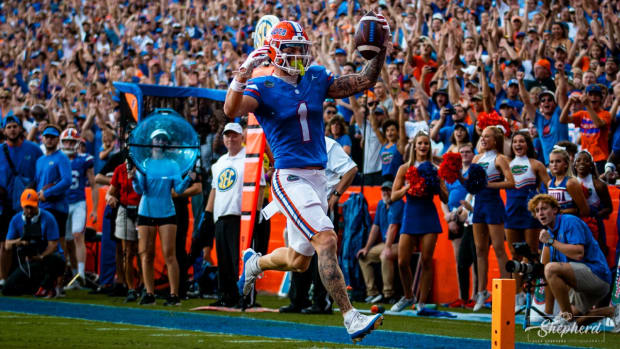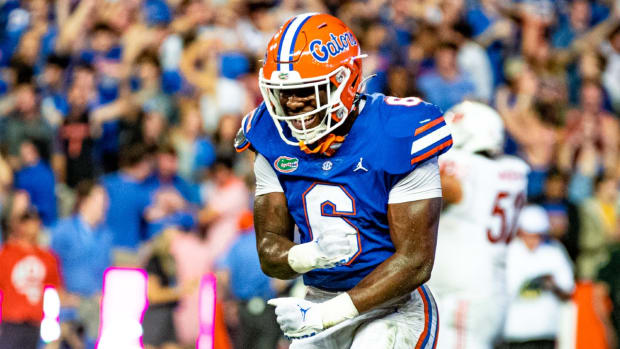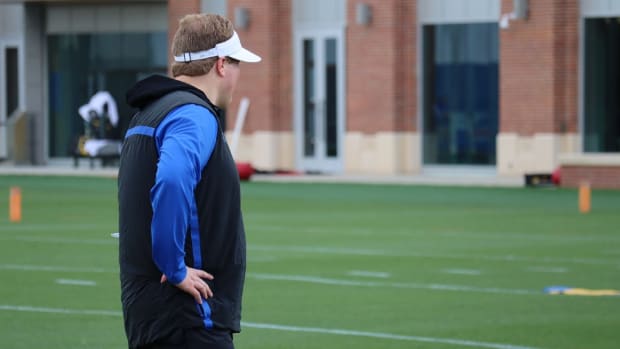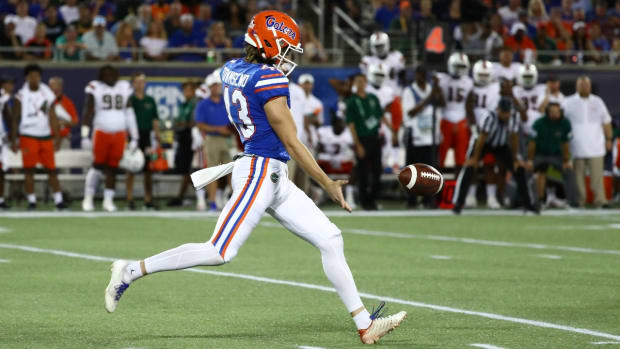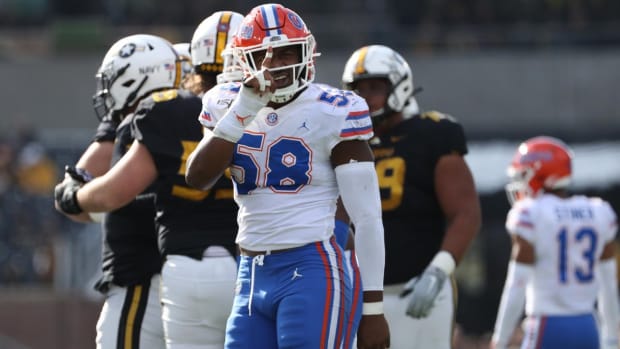Projecting the Florida Gators 2020 Fall Camp WR Depth Chart
After what feels like the longest offseason in recent memory, the Florida Gators are set to kick off their fall football camp this Friday, August 7th.
Until then, we'll be projecting the Gators' depth chart, position by position to familiarize fans with the roster that head coach Dan Mullen and staff yield this year. We have already gone over the quarterbacks and running backs, now it's time to take a look at a position depleted of veteran talent but packed with young potential.
The Gators graduated four NFL-bound wide receivers this offseason, obviously dampening the team's outlook at the position as Florida loses plenty of notable experience. However, several high-upside contributors are set to take on bigger roles in place of those veterans and the passing offense should not drop off too drastically.
X-receiver
Often isolated at the boundary, the X-receiver is usually tasked with beating press coverage. Size and speed are the skills to have at X, and Florida has recruited plenty of prospects who fit that mold over the past couple of classes.
1. Trevon Grimes
Florida's most seasoned returning wide receiver is Trevon Grimes, a former Ohio State pledge who transferred to UF after one season. Grimes gained immediate eligibility and has contributed ever since, but has yet to ascend to his five-star status as he's had plenty of veterans ahead of him.
Now Florida's de-facto No. 1 receiver, as he's produced more than anyone else with 59 receptions for 855 yards and five touchdowns over two years, Grimes is in a position to emerge as a legitimate threat for the Gators as a senior. A menacing deep-threat provided his size - 6-5, 214 lbs. - and speed, clocking a 4.47-second 40 yard dash in high school, Grimes averages 14.5 yards per catch and has churned out 39 first downs across his 59 catches, per Pro Football Focus.
2. Justin Shorter
Should he receive immediate eligibility, Shorter offers a similar skill-set to that of Grimes and his background as the No. 1 receiver in the class of 2018, paired with two years of college experience, suggest he could make a quick jump up the depth chart.
Shorter saw his role increase as a redshirt freshman, taking the field for 285 snaps and hauling in 12 catches across 19 targets for 137 yards in 2019. However, as his target share was minimal, Shorter looked to Florida's spread-out passing attack as an upgrade for his services as the team saw eight receivers post 20 or more receptions a year ago.
Fellow recent transfer, running back Lorenzo Lingard, has already been cleared to play this year by the NCAA. Although the process is rarely transparent or consistent, it's safe to assume we will know Shorter's fate sooner rather than later as he transferred in January.
3. Ja'Markis Weston
After receiving plenty of hype from his teammates last year, along with classmates Trent Whittemore and Dionte Marks (who recently transferred to Ole Miss), Weston has some high expectations to meet as a redshirt freshman.
Standing at 6-3, 217 lbs., Weston made a living on routes on the vertical stem as a high school prospect and is well-suited to do so in college with his size and length to contest catches at the boundary. Advancements in his route running and technique are needed from his college tape, and after a year of development in Florida's loaded receiver room, we'll soon see if those refinements have come to fruition.
4. Xzavier Henderson
A highly-rated, late addition to Florida's class, Henderson holds one of the strongest cases of any 2020 signee to take the field early in his Gators career. Measuring in at 6-4, 192 lbs. and having previously posted both a 4.55-second 40-yard dash and an 11.06 100-meter dash, Henderson's breakaway and long-speed is evident on tape and his skill-set is a perfect fit for X-receiver.
Playing with fantastic body control in the air and concentration to secure the football in the air, Henderson's upside at the boundary os arguably as great as anyone's on the roster. Weston signed as more of a project, meaning Henderson absolutely has a case to jump him on the depth chart should he stand out immediately in fall camp. Should Shorter not receive eligibility, Henderson could even jump as high as the No. 2 spot.
Z-receiver
The Z-receiver, who often lines up with a slot receiver or tight end to his side, often resembles a possession receiver who can run strong routes and combinations to his side of the field. Also usually tasked with being a strong run-blocker.
1. Jacob Copeland
After two years of flashes following his high-profile recruitment, Jacob Copeland is finally set to start in Florida's offense this year - should he even play. Copeland has hinted at the possibility of opting-out of the season amidst the coronavirus pandemic.
Should he play, however, Copeland is certainly dynamic and has grown as a route-runner over time at Florida to pair with his explosive skill-set. The 6-0, 192 lb. receiver clocked a 4.44-second 40 yard-dash and jumped 37.4 inches vertically coming out of high school, truly elite intangibles for a prospect. In limited playing time, Copeland has put those skills to the test and accumulate 22 receptions for 289 yards and two touchdowns.
2. Rick Wells
Across four years at Florida, Wells has yet to provide much to Florida's passing game but his experience could pay some dividends entering his final season. Wells has dealt with suspensions and plenty of talent around him, which has led to limited action despite 19 game appearances.
Wells has caught three passes for 33 yards over the past two seasons, averaging 90 snaps per season - fairly split between outside and slot receiver, meaning he could slide inside if necessary. At least earlier in the 2020 season, expect to see Wells on the field a bit more as a part of the rotation at wide receiver, but should he fail to stand out, younger prospects could snatch away snaps.
3. Trent Whittemore
Weston's counterpart as a member of the 2019 signing class, Whittemore is a local standout from Buchholz High School, the son of a football coach, and has experience playing both outside and slot receiver, along with safety. College ball is obviously a different animal, but his versatility and usage and high school compliment Whittemore's football IQ and make him a sleeper to take on a big role going forward.
Whittemore is a longer receiver at 6-3, 192 lbs., suggesting he could play X-receiver as well, but the amount of bodies already at the position and his versatility push him to the opposite side at Z. With ample footwork and length, Whittemore does a good job separating at the top of his route and getting open at different levels of the field.
4. Ja'Quavion Fraziars
Another X-receiver candidate playing Z, Fraziars carries a playing style similar to New England Patriots' WR N'Keal Harry. While his physical profile suggests he should play the boundary, Fraziars utilizes his length to make impressive catches in traffic while shining in the short-field on slants, screens, and routes that allow him to make things happen after the catch.
Fraziars has a better case to redshirt than Henderson in 2020, but don't sleep on his skill-set meshing well with the route combinations that quarterback Kyle Trask is most comfortable with in the short game.
Slot receiver
Easily identifiable, the slot receiver lines up closer to the line of scrimmage and usually on the inside shoulder of the Z-receiver, although it varies depending on formations and personnel. Slots have evolved from purely being speedsters up the seam, taking on roles across the middle of the field and in route combinations.
1. Kadarius Toney
Another opt-out candidate, Kadarius Toney's decision regarding the 2020 season could create serious implications as Florida's slot depth is not well defined. Toney is an explosive athlete who demands touches in multiple phases of the game, but is expected to become a more consistent receiver as a senior and take over the starting slot position after the graduations of Freddie Swain and Josh Hammond.
Toney has averaged 10.6 yards from scrimmage per touch over the past three years, and his abilities to make defenders miss have been well-documented. Those skills have yet to translate towards a polished receiving skill-set, but it's impossible to keep Toney off the field and the staff can get creative with him at slot.
2. Jordan Pouncey
Across his three years at Texas, Pouncey failed to do much of anything other than participate on special teams. As a contributor on offense, Pouncey tallied only two receptions for 19 yards, with all of his snaps at wide receiver coming from the slot position.
While his box score doesn't offer much to get excited about, Pouncey's college experience and time at slot appear more important than ever as Toney's commitment to playing this year is up in the air. Should a change in scenery do him well, Pouncey stands plenty to gain from his transfer to Florida and might receive a great opportunity this year if the ball rolls his way.
Final Thoughts
Losing four NFL-bound wide receivers is never a good thing for a college offense, but luckily for the Gators, a veteran quarterback and an ample amount of bodies in the wide receiver room should lead to a minimal drop-off in production.
Look for Grimes and Copeland to take on leadership roles in the room, assuming both end up taking the field this year, as the two are the most physically talented veterans of the group and have a great understanding of the system. From that point on, its anyone's game as wide receivers coach Billy Gonzales is fond of splitting snaps between his guys.
